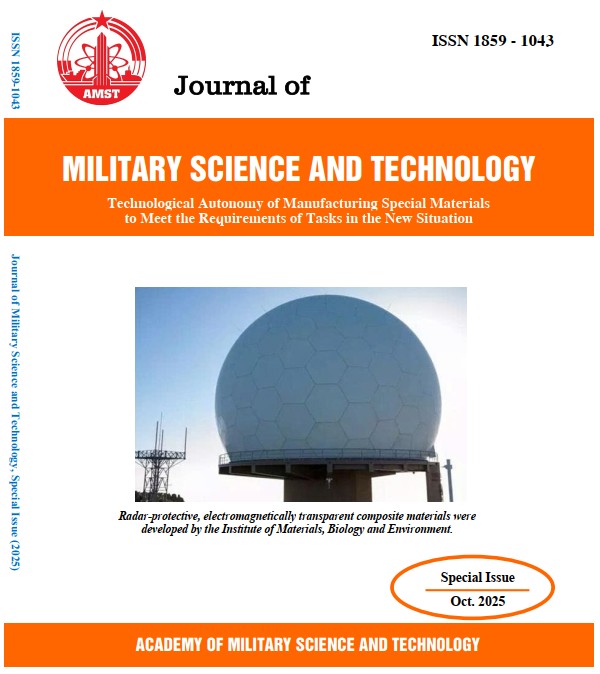Nghiên cứu thu hồi và tái sử dụng vật liệu sắt (nZVI) trong hệ Sono-Photo-Fenton-like để xử lý nước thải chứa TNT
DOI:
https://doi.org/10.54939/1859-1043.j.mst.IMBE.2025.129-135Từ khóa:
Sono-Photo-Fenton-like; nZVI; TNT; Thu hồi sắt.Tóm tắt
Nghiên cứu này đánh giá hiệu quả của việc thu hồi và tái sử dụng nano sắt hóa trị không (nZVI) trong xử lý nước thải chứa TNT bằng quá trình Sono-Photo-Fenton-like (SPF-like). Thí nghiệm được tiến hành trong điều kiện tối ưu cố định: pH = 2,5; H₂O₂ = 40 mM; và nồng độ TNT ban đầu = 50 mg/L. Kết quả cho thấy vật liệu nZVI sau thu hồi vẫn duy trì được hoạt tính xúc tác tốt, với hiệu suất loại bỏ TNT đạt trên 24% sau 4 chu kỳ tái sử dụng liên tiếp. Khi vật liệu sắt thu hồi khô được kết hợp với nZVI mới theo tỷ lệ 1:1 (1,0 mM nZVI và 1,0 mM Fe(OH)₃), hiệu suất xử lý đạt 94,85%, đồng thời giảm 50% lượng vật liệu mới cần sử dụng. Những kết quả này chứng minh tính khả thi trong việc thu hồi và tái sử dụng sắt trong các hệ thống oxy hóa nâng cao, góp phần duy trì hiệu suất xử lý cao, đồng thời giảm chi phí vận hành và lượng chất thải phát sinh trong xử lý nước thải công nghiệp có chứa các chất ô nhiễm bền vững như TNT.
Tài liệu tham khảo
[1]. Spanggord, R. J. and Suta, B. E. “Effluent analysis of wastewater generated in the manufacture of 2,4,6-trinitrotoluene. 2. Determination of a representative discharge of ether-extractable components.” Environmental Science & Technology, 16(4), 233–236 (1982).
[2]. Liou, M.-J., Lu, M.-C., and Chen, J.-N. “Oxidation of TNT by photo-Fenton process.” Chemosphere, 57(9), 1107–1114 (2004).
[3]. Van Nguyen, H., et al. “Effective treatment of 2,4,6-trinitrotoluene from aqueous media using a sono–photo-Fenton-like process with a zero-valent iron nanoparticle (nZVI) catalyst.” RSC Advances, 14(33), 23720–23729 (2024).
[4]. Moradi, M., et al. “A review on pollutants removal by Sono-photo-Fenton processes.” Journal of Environmental Chemical Engineering, 8(5), 104330 (2020).
[5]. Walling, S. A., et al. “Fenton and Fenton-like wet oxidation for degradation and destruction of organic radioactive wastes.” npj Materials Degradation, 5(1), 50 (2021).
[6]. Cao, G. M., et al. “Regeneration and reuse of iron catalyst for Fenton-like reactions.” Journal of Hazardous Materials, 172(2–3), 1446–1449 (2009).
[7]. Ayanda, O. S et al. “Ultrasonic degradation of aqueous phenolsulfonphthalein (PSP) in the presence of nano-Fe/H₂O₂.” Ultrasonics Sonochemistry, 47, 29–35 (2018).
[8]. Liu, J., et al. “Selective removal of nitroaromatic compounds from wastewater in an integrated zero valent iron (ZVI) reduction and ZVI/H₂O₂ oxidation process.” RSC Advances, 5(71), 57444–57452 (2015).
[9]. Shukla, N., et al. “2,4-Dinitrotoluene (DNT) and 2,4,6-Trinitrotoluene (TNT) removal kinetics and degradation mechanism using zero valent iron-silica nanocomposite.” Journal of Environmental Chemical Engineering, 6(4), 5196–5203 (2018).
[10]. Hussain, S et al. “Catalytic activity of metals in heterogeneous Fenton-like oxidation of wastewater contaminants: A review.” Environmental Chemistry Letters, 19(3), 2405–2424 (2021).
[11]. Zhang, X., et al. “Degradation of 2,4,6-trinitrotoluene (TNT) from explosive wastewater using nanoscale zero-valent iron.” Chemical Engineering Journal, 158(3), 566–570 (2010).







